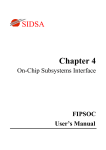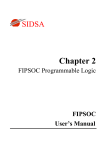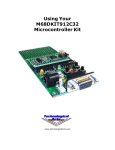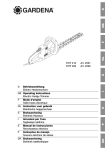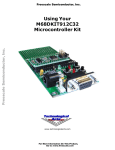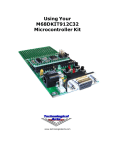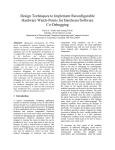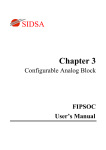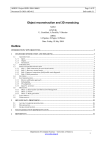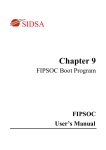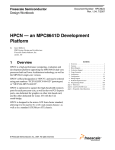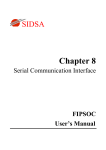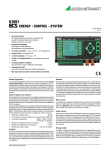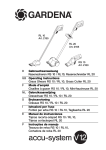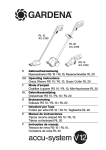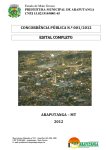Download FIPSOC User Manual
Transcript
SIDSA Chapter 6 External Interrupts Controller FIPSOC User’s Manual SIDSA Semiconductor Design Solutions External Interrupts Controller The control logic for each external interrupt input is duplicated so the same interrupt sources are available for each input. Masks are different for each duplicated input and in fact this is a convenient way to specify relative priorities between two interrupt sources. There are nine interrupt sources, independently masked for each interrupt input. Each one may be inverted, so both low and high levels and rising and falling transitions are allowed. Multiple interrupt vectors are also supported. In normal operation, the interrupt vector is unique for each one of the two external interrupt inputs. The External Interrupt Controller (EIC block) provides an enhanced multiple interrupt vector mode which selects the interrupt vector from a user-defined table of registers. Chapter 6. External Interrupts Controller Programmable Hardware Interrupts 1 - 4 End of Conversion PLL stabilization Clock Generation Block Serial Comm. Block Stop Interrupt EIC Block Program Code Bus Program Address Bus PL Block External Data Bus External Data Address Bus • Interrupts generated by the on-chip subsystems, • Custom interrupts generated in the Programmable Logic Block Comm. Interrupt This chapter describes the interrupt controller added to the external interrupts service circuitry of the builtin 8051. This block is used to extend the two available external interrupt sources in the standard mP8051 to all the on-chip subsystems of the FIPSOC. Thus, a full interrupt service interface has been customized and integrated in the FIPSOC chip. The interrupts service system of the on-chip core of the 8051 keeps the same interrupt requesting system of the original 8051, even though there has been integrated an external interrupt controller to expand the limit of two external interrupt sources allowed by the original 8051 (see figure 1.1). These sources may be grouped into two: SW BreakPoint Interrupt The Field Programmable System On Chip (FIPSOC) constitutes a new concept in system integration. It provides the user with the possibility of integrating a microprocessor core along with programmable digital and analog cells within the same integrated circuit. This chip can be considered as a large granularity FPGA with a FPAA (Field Programmable Analog Array) and a built-in microprocessor core that does not only act as a general purpose processing element, but also configures the programmable cells and their interconnections. Therefore, there is a strong interaction between hardware and software as long as signal values and configuration data within the programmable cells are accessible from microprocessor programs. 1. Interrupt System Description CAB Overview INT0 INT1 8051 Debugging Block Fig. 1.1: Block Diagram of the Interrupt System 1.1. 8051 Interrupt Service Routine The mP8051 provides five interrupt sources with two priority levels (as shown in figure 1.2): ü The 8051 external interrupts can each be either level-activated or transition-activated, depending on bits IT0 and IT1 in register TCON. The flags that actually generate these interrupts are bits IE0 and IE1 of TCON. The interrupt flag is cleared a) by the hardware, when the service routine is vectored to, only if the interrupt was transitionactivated; b) by the external requesting source (which controls the request flag), if the interrupt was level-activated. 2 SIDSA ü Timer0 and Timer1 interrupts are generated by bits TF0 and TF1, which are set by the rollover in their respective timer/counter registers. The interrupt flag is cleared by the on-chip hardware when the service routine is vectored to. Semiconductor Design Solutions The interrupt sources are described in table 1.1. Note that one of the sources can only interrupt thshare the same interrupt IE0 IT1 IE1 TF0 RI TI Fig. 1.2: mP8051 Interrupt Sources All the bits that generate interrupts can be set or cleared by software, with the same result as though it had been set or cleared by hardware. Each of these interrupt sources may be individually enabled or disabled. The 8051 also provides a global disable bit which disables all interrupts at once. Each interrupt source can also be individually programmed to one of two priority levels by setting or clearing a bit on the register located in $B8 of the SFR map. A lower-priority interrupt can itself be interrupted by a higher-priority interrupt, but no t by a lower-priority interrupt. If request of the same priority level are received simultaneously, an internal polling sequence determines which request is serviced (see Microprocessor Document for further information) 1.2. HW1/COM CKint HW2 DBGint HW3 HW4 CABint Table 1.1: Interrupt Sources TF0 INT1 PLL stabilization (highest priority) Programmable Hardware interrupt #1 / Serial Communication Block Interrupt Clock Generation Block: clock stop Programmable Hardware interrupt #2 Software breakpoints Programmable Hardware interrupt #3 Programmable Hardware interrupt #5 End of Conversion of the ADCs External Interrupts Controller Each interrupt signal is connected to the internal channels of the External Interrupt Controller Block. The output of these channels is connected to the external interrupt inputs (INT0 and INT1) of the mP8051. All the signals may be independently inverted and masked in each channel. A priority circuitry is provided to solve simultaneous request conflicts between different sources. Figure 1.3 schematically shows the block diagram of the External Interrupt Controller. EIMR0[6] Priority within level IT0 Priority within level ü The Serial Port Interrupt is generated by the logical OR of RI and TI. Neither of these flags is cleared by hardware when the service routine is vectored to. INT0 Description Source PLLint SGN 0 COM INT EIMR 0 Channel # 0 TSR 0 PLL INT HW1 INT 0 CK INT HW2 ISR DBG INT HW3 INT 1 HW4 ANA INT TSR 1 Channel # 1 SGN 1 EIMR 1 Fig. 1.3: Block Diagram of the EIC Block An interrupt controller block to complement the interrupt system of the built-in 8051 has been inergrated. This controller expands to nine the number of interrupt sources connected to the interrupt system. Therefor, different subsystems would be able to request a hardware interrupt in the microprocessor . Both channels of the EIC Block are independently controlled (they have separate registers): mask and polarity registers are duplicated. Only the Interrupt Status Register is not available on each channel, since this register is the logical OR of the Temporal Status Register (TSR0 and TSR1) of the channels (as depicted from figure 1.3). The 8051 core can be externally interrupted by one of the nine new interrupt sources through any of the external interrupt inputs; that is, hardware for both interrupt inputs has been duplicated to provide higher flexibility. Signal HW1 in channel #0 has a double function: if its corresponding bit in the mask register is set, the Programmable Hardware Interrupt 1 is selected: otherwise, Serial Communication Block Interrupt is selected. Chapter 6. External Interrupts Controller 3 SIDSA Finally, an enhanced mode is provided from the External Interrupt Controller Block. This mode supports multiple interrupt vectors for the 8051 external interrupt sources. That is, only one interrupt vector each external interrupt input is provided by the on-circuitry when the interrupt routine is called. If the enhanced mode is disabled, the programmer would have to identify which of the nine new sources has caused the interrupt. This mode is called normal or basic mode. In the enhanced mode, a user-definable vector table is provided (located in the SFR map of the 8051), and no action from the programmer is needed, since the interface selects the corresponding vector. This operation is totally transparent to the mP8051 as long as the register is multiplexed via hardware. The corresponding flag in the Interrupt Status Register is also cleared when the service routine is vectored to, only if the interrupt was transition-activated. Semiconductor Design Solutions System Control Register 3 (h02 after Reset, 12x8 device) Address $9B Name RG3 Bit INTM RG3.7 RG3.6 RG3.5 RG3.4 RG3.3 RG3.2 CM1 RG3.1 CM0 RG3.0 Address $A7,$A6 Name VHW1 Byte $A6 $A7 VHW1L VHW1H The Global Interrupt system of the FIPSOC is controlled using registers located in the SFR map. These registers can be divided into three groups: ü Original 8051 registers used to control the on-core interrupt system of the 8051 (see Microprocessor Document), ü Interrupt related Registers included in the different subsystems of the FIPSOC. These registers are explained in their corresponding Documents (Configurable Analog Block Document, Software Debugging Block Document, Clock Generation Block Document, and PL Block Document). The SFR used to control the External Interrupt Controller Block are described below: Address $A5,$A4 Name VPLL Byte $A4 VPLLL $A5 VPLLH Description PLL Interrupt Vector. Pseudovector used when extended interrupt mode is enabled (INTM = 1), external interrupt and PLLint are enabled and an Interrupt from PLL happens. PLL Interrupt Vector Low Byte PLL Interrupt Vector High Byte Chapter 6. External Interrupts Controller Description HW Interrupt Vector 1 Pseudovector used when extended interrupt mode is enabled (INTM = 1), external interrupt is enabled and a) HW1int are enabled and an Interrupt from the PLblock happens; or is disabled, b) HW1int BOOTint is enabled and an the communication system produce HW1 Interrupt Vector Low Byte HW1 Interrupt Vector High Byte Clock Interrupt Vector (h0000 after Reset) Address $AD,$AC Name VCLK Byte $AC $AD VCLKL VCLKH Description CLK Interrupt Vector. Pseudovector used when extended interrupt mode is enabled (INTM = 1), external interrupt and CLKint are enabled and clocks are frozen, either by software or hardware CLK Interrupt Vector Low Byte CLK Interrupt Vector High Byte Programmable Hardware vector 2 (h0000 after Reset) Address $AF,$AE PLL Interrupt Vector (h0000 after Reset) Interrupt mode. If 1, extended interrupt vectors mode is entered, if 0, basic 8051interrupt mode is selected External Memory Compatible map bit 1 External Memory Compatible map bit 0 Programmable Hardware vector 1 (h0000 after Reset) 2. EIC Block Registers ü EIC Registers used to control this block. The registers are: two mask and two polarity registers (one pair for each channel) used to control each interrupt source signal, and the Interrupt Status Register from which information is obtained. Description System Control Register 3 Name VHW2 Byte $AE $AF VHW2L VHW2H Description HW2 Interrupt Vector. Pseudovector used when extended interrupt mode is enabled (INTM = 1), external interrupt and HW2int are enabled and an Interrupt from the PLblock happens through HW2INT input. HW2 Interrupt Vector Low Byte HW2 Interrupt Vector High Byte 4 SIDSA SW Breakpoints Interrupt Vector (h0000 after Reset) Address $B5,$B4 Name VDBG $B4 $B5 Byte VDBGL VDBGH Description DEBUG Interrupt Vector. Pseudovector used when extended interrupt mode is enabled (INTM = 1), external interrupt and DBGint are enabled and a memory location is debbuged (a breakpoint is reached). DBG Interrupt Vector Low Byte DBG Interrupt Vector High Byte Semiconductor Design Solutions Extended Interrupt Mask Register 0 (h00 after Reset) Address $C0 Name EIMR0 EIMR0.7 EIMR0.6 EIMR0.5 Programmable Hardware vector 3 (h0000 after Reset) Address $B7,$B6 Name VHW3 $B6 $B7 Byte VHW3L VHW3H Description HW3 Interrupt Vector. Pseudovector used when extended interrupt mode is enabled (INTM = 1), external interrupt and HW3int are enabled and an Interrupt from the Plblock happens through HW3INT input. HW3 Interrupt Vector Low Byte HW3 Interrupt Vector High Byte Programmable Hardware vector 4 (h0000 after Reset) Address $BD,$BC Name VHW4 $BC $BD Byte VHW4L VHW4H EIMR0.4 EIMR0.3 EIMR0.2 EIMR0.1 EIMR0.0 $BF,$BE Name VANA Byte Address $C1 Name EIMR1 Description HW4 Interrupt Vector. Pseudovector used when extended interrupt mode is enabled, external interrupt and HW4int are enabled and an Interrupt from the PLblock happens through HW4INT input. HW4 Interrupt Vector Low Byte HW4 Interrupt Vector High Byte $BE VANAL $BF VANAH Description Analog Interrupt Vector. Pseudovector used when extended interrupt mode is enabled (INTM = 1), external interrupt and analog inerrupt enabled and an A-D conversion is finished. Analog Interrupt Vector Low Byte Analog Interrupt Vector High Byte Description Extended Interrupt Mask Register for External Interrupt 0. A 0 means that the corresponding source is masked. Enable or Disable PLL interrupt through IX0 HW1 / COM interrupt through External Int 0 (if 1, HW1 is selected) Enable or Disable CLK interrupt through External Int 0 Enable or Disable HW2 interrupt through External Int 0 Enable or Disable DBG interrupt through External Int 0 Enable or Disable HW3 interrupt through External Int 0 Enable or Disable HW4 interrupt through External Int 0 Enable or Disable ANA interrupt through External Int 0 Extended Interrupt Mask Register 1 (h00 after Reset) Bit EIMR1.7 EIMR1.6 EIMR1.5 EIMR1.4 EIMR1.3 End of Conversion Interrupt Vector (h0000 after Reset) Address Bit EIMR1.2 EIMR1.1 EIMR1.0 Description Extended Interrupt Mask Register for External Interrupt 1. A 0 means that the corresponding source is masked Enable or Disable PLL interrupt through External Int 1 Enable or Disable HW1 interrupt through External Int 1 Enable or Disable CLK interrupt through External Int 1 Enable or Disable HW2 interrupt through External Int 1 Enable or Disable DBG interrupt through External Int 1 Enable or Disable HW3 interrupt through External Int 1 Enable or Disable HW4 interrupt through External Int 1 Enable or Disable ANA interrupt through External Int 1 Polarity Register 0 (h00 after Reset) Address $C2 Name SGNI0 Byte Description Inverting extended external Interrupts through Ext. Int. 0 For each bit of this register, if 1, inverts the corresponding interrupt input (high level or rising edge interrupts). Polarity Register 1 (h00 after Reset) Address $C3 Chapter 6. External Interrupts Controller Name SGNI1 Byte Description Inverting extended external Interrupts through Ext. Int. 1 For each bit of this register, if 1, inverts the corresponding interrupt input (high level or rising edge interrupts). 5 SIDSA Extended Interrupt Status Register (h00 after Reset) Address $C4 Name IRS IPLL IHW1 ICLK IHW2 IHW3 IDBG IHW4 IANA Bit ISR.7 ISR.6 ISR.5 ISR.4 ISR.3 ISR.2 ISR.1 ISR.0 Description Extended Interrupt Status Register. Each bit is set by HW when the corresponding interrupt occurs, and also cleared by HW when IRS is read (see later in the text). PLL Interrupt flag. HW1 Interrupt flag Clock Stop Interrupt flag HW2 Interrupt flag HW3 Interrupt flag SW Breakpoints Interrupt flag HW4 Interrupt flag Analog Interrupt flag 3. Programming the EIC Block This section will describe how the external interrupts INT0 and INT1 of the 8051 core may be programmed. There are not big differences between programming the original interrupt system and the EIC-8051 system of the FIPSOC. Each of the interrupt sources can be individually enabled or disabled by setting or clearing the corresponding bit: ü IE Register (SFR $A8), enables or disables the five original interrupt sources of the 8051 (INT0, INT1, TF0, TF1 and RI+TI), by setting or clearing its corresponding bit, respectively. ü Extended interrupt sources can be enabled or disabled writing on the corresponding bit of EIMR0 and EIMR1 masks registers (SFR $C0 and SFR $C1). Not that bits IE[0] and IE[2] are used as a global disable for both channel #0 (INT0) and channel #1 (INT1), respectively. ü There is an special bit in EIMR0 (EIMR0[6]), used as a selecting bit instead of a masking bit. If this bit is set, Programmable Hardware Interrupt 1 is selected; otherwise, Serial Communication Block Interrupt is enabled. ü IE register contains a global disable bit, IE[7], which disables all interrupts at once. Semiconductor Design Solutions (that is, PLL interrupt, Hardware sources, etc.) of the corresponding channel in the EIC Block. ü A low priority interrupt can itself be interrupted by a high-priority interrupt. ü A high priority interrupt cannot be interrupted by any other interrupt source. Even more, no interrupt source can be interrupted by any other source within level ü If two requests of the same priority level are received simultaneously, an internal polling sequence determines which request is serviced (see figure 1.2. and Table 1.1) External Interrupt sources in the on-chip 8051 can only interrupt if a low level or a 1-to-0 transition is entered (depending on the configuration of bits IT0 and IT1 of TCON –SFR $88-). Two new registers have been added to the SFR map of the 8051 core of the FIPSOC to configure the polarity of the incoming interrupt signal. Each interrupt input of both channels of the External Interrupt Controller Block can be individually inverted clearing the corresponding bit of SGNI0 and SGNI1 (SFR $C2 and SFR $C3). Table 3.1 shows this configuration. SGNI0 [i] SGNI1 [i] IT0 (TCON[0]) IT1 (TCON[1]) Interrupt 0 1 0 1 0 0 1 1 High level Low level 0-to-1 transition 1-to-0 transition Table 3.1: Interrupt triggering condition When an interrupt is produced, the ISR register set the corresponding bit. If the conditions are right for it, the IE.x flag of SFR $88 will be set during the polling cycle. ü If IT.x = 1, external interrupt x is edge triggered; in this mode, if successive samples of the INTx input show a high in one cycle and a low in the next cycle, interrupt request flag IE.x in TCON register is set. Flag bit IE.x then requests the interrupt. ü Note that each subsystem interrupt signal may be programmed to be connected to both channels. Due to this flexibility, it is strongly recommended not to enable the same interrupt source in both channels. ü If various external sources interrupt simultaneously, the EIC block will register them. Each time one of the request interrupts is acknowledged the EIC block sets the corresponding IE.x flag, until all of the interrupts arrived were serviced (see figure 3.1). Each of the original interrupt sources can also be individually programmed to one of two priority levels (low and high) by setting or clearing a bit in IP register (SFR $B8): ü Besides the EIC Interrupt Status Registers, also status registers from other blocks must be correctly reinitialized if the interrupt system is to be used. Programmers would handle carefully. ü Note that the priority of the external interrupts sources of the 8051 (INT0 and INT1) is propagated to the non-masked extended inputs The 8051 of the FIPSOC is provided with two different operating modes. Bit 2 of the RG3 (SFR $9B) selects the active mode: normal or basic mode Chapter 6. External Interrupts Controller 6 SIDSA Semiconductor Design Solutions is selected if RG3[2]=0; extended mode is entered by setting this bit. This modes affects how the interrupt service routine is vectored to. In particular: 3.1. Basic Mode (RG3[2]=0) a) Only one vector register for each channel (external inputs) is provided. Programmer would decode by software which of the external subsystem has interrupted. b) When an external interrupt is generated, the flag that generated it is cleared by the hardware when the service routine is vectored to only if the interrupt was transition-activated. 3.2. a) Eight vector registers have been added to the SFR map. When the processor acknowledges an interrupt request, hardware LCALL to the appropriate servicing routine will be executed on the next instruction. The start address of the routine which is going to be vectored to depends on the source of the interrupt and it will be internally chosen. Addresses execution .... $XX14 $XX15 $XX18 DBG INT $XX20 → LCALL $0003 $0003: LJMP (VANA) The interrupt flags are sampled at S5P2 of every machine cycle. The samples are polled during the following machine cycle. If one of the flags was in a set condition at S5P2 of the preceding cycle, the polling cycle will find it and the interrupt system will generate a hardware LCALL to the appropriate service routine. The address field of the instruction is hardware generated and its value depends on the source of the interrupt. As mentioned before, a different vector table is used depending on the selected mode. 4.1. Extended Mode (RG3[2]=1) ANAINT 4. Interrupt Routine Vectors The routines of the five interrupt sources of the 8051 occupy the lowest locations of the Program Memory. Execution proceeds from the location determined by the vector until the RETI instruction is encountered. Table 4.1. shows the vector table used in the basic mode. The Internal ROM includes a LJMP to $FFXX instructions in each vector address. These instructions point to the auxiliary memory where users may define their interrupt routine. Interrupt request flag Interrupt Source IE0 TF0 IE1 TF1 RI+TI External Interrupt 0 Timer 0 overflow External Interrupt 0 Timer 1 overflow Serial Channel .... HW1 INT RETI $XX20 .... RETI Interrupts arrived $XX21 Execution time $XX23 → LCALL $0003 $0003: LJMP (VDBG) .... Input vector address $0003 ? $000B? $0013? $001B? $0023? $FF03 $FF0B $FF13 $FF1B $FF23 Table 4.1: Interrupt vectors table Polling sequence selection $XX21 → LCALL $0003 $0003: LJMP (VHW1) Basic Mode RETI $XX23 $XX26 .... Figure 3.1: Interrupt registering in the extended mode 4.2. Extended Mode Same table as the basic mode interrupt vector table is used in the extended mode. When an external interrupt flag is set and the hardware LCALL jumps to the routine address ($0004 and $0013 for flags IE0 and IE1, respectively), a HW-LJMP instruction is executed. The address field of the instruction depends on the source of the interrupt (see figure3.1). Values from the SFR map are used, as shown in Table 4.2. Note that the same vectors are used in both external interrupts. b) When an external interrupt is generated, the flag that generated it and the flag bit in the Temporal Status Register of the corresponding channel of the EIC block are cleared by the hardware when the service routine is vectored to (only if the interrupt was transition-activated),. Note that the clearing action updates the Temporal Status Registers, not to the Interrupt Status Register (ISR). Chapter 6. External Interrupts Controller 7 SIDSA Interrupt request flag of ISR Interrupt Source Input vector address IPLL PLL stabilization (VPLL) IHW1 Programmable HW 1 (VHW1) ICLK Clock stop (VCLK) IHW2 Programmable HW 2 (VHW2) IDBG SW Breakpoints (VDBG) IHW3 Programmable HW 3 (VHW3) IHW4 Programmable HW 4 (VHW4) IANA End of Conversion (VANA) (REG) → value stored in REG regsiter Table 4.2: Extended Interrupt vectors table The first LCALL instruction is done to locations of the Program Memory. Different routines may be accessed depending on the portion of the program memory enabled. That is, three different destination routines can be called: on-chip ROM, external program memory and Regular Configuration memory mapped in the program memory. The on-chip ROM has stored another LJMP instructions in all the routines. New pseudovectors are used (see table 4.3.). Note that if the Auxiliary Memory is enabled, a user-definable vector table is obtained. These vectors can be dynamically modified because Auxiliary Memory can be mapped in both program and data memories. Interrupt request flag Input vector address LJMP address IE0* TF0 IE1* TF1 RI+TI $0003 $000B $0013 $001B $0023 $FF03 $FF0B $FF13 $FF1B $FF23 Semiconductor Design Solutions If the interrupt system is working on the extended mode, only one routine location is possible (there exists a dedicated hardware to execute the LJMP using SFR vectors). See Microprocessor information. Document for further 5. Step-by-step Execution The 8051 interrupt system allows step-by-step execution with very little software overhead. Once an interrupt routine has been entered, it cannot be reentered until at least one instruction of the interrupted program is executed. One way to use this feature for step-by-step operation is setting one of the two external interrupts to be level-activated, and a continuous active level (high or low level depending on the SGNx bit) in its input. The continuous active level is set by manipulating the SFR $E2. If bit 7 in this register is set to 1, a high level in the DBG interrupt source is set. The levelactivated configuration is set with IT0 = 0. See Software Debugging Document for further information. Table 4.3: On-chip ROM Interrupt Table. Chapter 6. External Interrupts Controller 8








